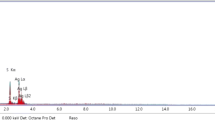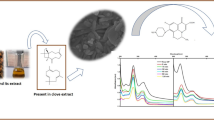Abstract
The aim of this research is synthesis of a promising bacterial elimination nanohybrid for water disinfection. Hence dextrin, a carbohydrate polymer composed of linear α-(1,4)-linked d-glucose, is used as an intermediate to prepare Fe3O4–dextrin–CoS nanohybrid. At the first step magnetic dextrin was prepared by one step ultrasound assisted route using Fe2+ as iron source and dextrin as capping agent. At the second step functional groups of dextrin was employed to trap Co2+ ions for decorating CoS at the biosorbent structure through refluxing route. The structure of the magnetic dextrin and nanohybrid was studied by XRD, EDX, FESEM, TGA and zeta potential measurement. EDX and TGA results confirmed that the CoS has been decorated with high density onto magnetite dextrin structure. The prepared nanohybrid has been employed to capture Escherichia coli as a sample pathogen from water solution. Effective parameters on bacterial elimination, i.e., pH, contact time, nanohybrid dosage and presence of anions have been studied. Results showed that at pH of 3.5, contact time of 15 min and nanohybrid dosage of 20 mg E. coli capturing efficacy was more than 99% which confirmed high efficiency of the nanosystem in bacteria elimination from water solution.









Similar content being viewed by others
References
J. Fawell, M.J. Nieuwenhuijsen, Contaminants in drinking water. Br. Med. Bull. 68, 199–208 (2003). https://doi.org/10.1093/bmb/ldg027
Y. Junejo, M. Safdar, M.A. Akhtar, M. Saravanan, H. Anwar, Synthesis of tobramycin stabilized silver nanoparticles and its catalytic and antibacterial activity against pathogenic bacteria. J. Inorg. Organometal. Polym. Mater. 29, 111–120 (2019). https://doi.org/10.1007/s10904-018-0971-z
J. Huang, G. Huang, C. An, X. Xin, X. Chen, Y. Zhao, R. Feng, W. Xiong, Exploring the use of ceramic disk filter coated with Ag/ZnO nanocomposites as an innovative approach for removing Escherichia coli from household drinking water. Chemosphere 245, 125545 (2020). https://doi.org/10.1016/j.chemosphere.2019.125545
S.G. Mulamattathil, C. Bezuidenhout, M. Mbewe, C.N. Ateba, Isolation of environmental bacteria from surface and drinking water in Mafikeng, South Africa, and characterization using their antibiotic resistance profiles. J. Pathog. 2014, 371208 (2014). https://doi.org/10.1155/2014/371208
O. Infections, L.H. Gould, R.K. Mody, P. Clogher, A.B. Cronquist, K.N. Garman, S. Lathrop, C. Medus, N.L. Spina, T.H. Webb, P.L. White, K. Wymore, R.E. Gierke, B.E. Mahon, P.M. Griffin, Increased recognition of non-O157 Shiga toxin-producing Escherichia coli infections in the United States. Foodborne Pathog. Dis. 10, 453–460 (2013). https://doi.org/10.1089/fpd.2012.1401
B.C. Weimer, M.K. Walsh, C. Beer, R. Koka, X. Wang, Solid-phase capture of proteins, spores, and bacteria. Appl. Environ. Microbiol. 67, 1300–1307 (2001). https://doi.org/10.1128/AEM.67.3.1300
Y. Jin, F. Liu, C. Shan, M. Tong, Y. Hou, Efficient bacterial capture with amino acid modified magnetic nanoparticles. Water Res. 50, 124–134 (2014). https://doi.org/10.1016/j.watres.2013.11.045
D. Vo, C. Lee, Antimicrobial sponge prepared by hydrophobically modified chitosan for bacteria removal. Carbohyd. Polym. 187, 1–7 (2018). https://doi.org/10.1016/j.carbpol.2018.01.082
P.Y. Furlan, A.J. Fisher, A.Y. Furlan, M.E. Melcer, D.W. Shinn, J.B. Warren, Magnetically recoverable and reusable nanoparticles for water disinfection. Invensions 2, 1–15 (2017). https://doi.org/10.3390/inventions2020010
M.J. Meziani, X. Dong, L. Zhu, L.P. Jones, G.E. Lecroy, F. Yang, S. Wang, P. Wang, Y. Zhao, L. Yang, R.A. Tripp, Y.P. Sun, Visible-light-activated bactericidal functions of carbon “quantum” dots. ACS Appl. Mater. Interf. 8, 10761–10766 (2016). https://doi.org/10.1021/acsami.6b01765
M. Zendehdel, B. Shoshtari, Y. Giuseppe, Removal of heavy metals and bacteria from aqueous solution by novel hydroxyapatite/zeolite nanocomposite, preparation, and characterization. J. Iran. Chem. Soc. 13, 1915–1930 (2016). https://doi.org/10.1007/s13738-016-0908-9
J. Liu et al., Yolk/shell nanoparticles: new platforms for nanoreactors, drug delivery and lithium-ion batteries. Chem. Commun. 47, 12578–12591 (2011)
S. Zavareh, E. Norouzi, Impregnation of GO with Cu2+ for enhancement of aniline adsorption and antibacterial activity. J. Water Process Eng. 20, 160–167 (2017). https://doi.org/10.1016/j.jwpe.2017.10.012
D. Mu, X. Mu, Z. Xu, Z. Du, G. Chen, Removing Bacillus subtilis from fermentation broth using alumina nanoparticles. Bioresour. Technol. 197, 508–511 (2015). https://doi.org/10.1016/j.biortech.2015.08.109
H.M.M. Ibrahim, M.S. Hassan, Characterization and antimicrobial properties of cotton fabric loaded with green synthesized silver nanoparticles. Carbohyd. Polym. 151, 841–850 (2016). https://doi.org/10.1016/j.carbpol.2016.05.041
S. Haq, K. Ansar, Y. Wajid, R. Muhammad, W. Muhammad, N. Ahmed, M. Imran, S. Nadia, S. Amreen, S. Mahfooz, U. Rehman, B. Khan, Green synthesis of silver oxide nanostructures and investigation of their synergistic effect with moxifloxacin against selected microorganisms. J. Inorg. Organometall. Polym. Mater. (2020). https://doi.org/10.1007/s10904-020-01763-8
I. Kheshtzar, M. Ghorbani, M. Pashai, Facile synthesis of smartaminosilane modified-SnO2/porous silica nanocomposite for high efficiency removal of lead ions and bacterial inactivation. J. Hazard. Mater. 359, 19–30 (2018). https://doi.org/10.1016/j.jhazmat.2018.07.028
M. Padervand, F. Asgarpour, A. Akbari, B.E. Sis, G. Lammel, Hexagonal core–shell–[SiO2[–MOYI]Cl–]Ag nanoframeworks for efficient photodegradation of the environmental pollutants and pathogenic bacteria. J. Inorg. Organometall. Polym. Mater. (2019). https://doi.org/10.1007/s10904-019-01095-2
Z. Wei, Z. Zhou, M. Yang, C. Lin, Z. Zhao, D. Huang, Z. Chen, J. Gao, Multifunctional Ag@Fe2O3 yolk–shell nanoparticles for simultaneous capture, kill, and removal of pathogen. J. Mater. Chem. 21, 16344 (2011). https://doi.org/10.1039/c1jm13691g
J.-A. Park, C.-G. Lee, S.-J. Park, J.-H. Kim, S.-B. Kim, Microbial removal using layered double hydroxides and iron (hydr)oxides immobilized on granular media. Environ. Eng. Res. 15, 149–156 (2010). https://doi.org/10.4491/eer.2010.15.3.149
Y. Jin, J. Deng, J. Liang, C. Shan, M. Tong, Efficient bacteria capture and inactivation by cetyltrimethylammonium bromide modified magnetic nanoparticles. Colloids Surf. B Biointerfaces 136, 659–665 (2015). https://doi.org/10.1016/j.colsurfb.2015.10.009
A. Orsuwan, S. Shankar, L.F. Wang, R. Sothornvit, J.W. Rhim, Preparation of antimicrobial agar/banana powder blend films reinforced with silver nanoparticles. Food Hydrocolloids 60, 476–485 (2016). https://doi.org/10.1016/j.foodhyd.2016.04.017
L. Li, J. Iqbal, Y. Zhu, P. Zhang, W. Chen, A. Bhatnagar, Y. Du, Chitosan/Ag-hydroxyapatite nanocomposite beads as a potential adsorbent for the ef fi cient removal of toxic aquatic pollutants. Int. J. Biol. Macromol. 120, 1752–1759 (2018). https://doi.org/10.1016/j.ijbiomac.2018.09.190
R. Kaveh, H. Alijani, M.H. Beyki, Magnetic polyresorcinol@CoFe2O4@MnS nanoparticles for adsorption of Pb(II), Ag(I), Cr(VI) and bacteria from water solution. Polym. Bull. 77, 1893–1911 (2020). https://doi.org/10.1007/s00289-019-02835-7
M. Hossein Beyki, S. Ehteshamzadeh, S. Minaeian, F. Shemirani, Clean approach to synthesis of graphene like CuFe2O4 @ polysaccharide resin nanohybrid: Bifunctional compound for dye adsorption and bacterial capturing. Carbohyd. Polym. 174, 128–136 (2017). https://doi.org/10.1016/j.carbpol.2017.06.056
M. Hossein Beyki, H. Alijani, Y. Fazli, Biosorption of aqueous lead and nickel by solvent-free synthesized flake-like polysaccharide resin. Desal. Water Treatm. 3994, 1–10 (2016). https://doi.org/10.1080/19443994.2016.1173596
A. Mittal, R. Ahmad, I. Hasan, Iron oxide-impregnated dextrin nanocomposite: synthesis and its application for the biosorption of Cr(VI) ions from aqueous solution. Desal. Water Treatm. 57, 15133–15145 (2016). https://doi.org/10.1080/19443994.2015.1070764
S. Perret, C. Sabin, C. Dumon, M. Pokorná, C. Gautier, O. Galanina, S. Ilia, N. Bovin, M. Nicaise, M. Desmadril, N. Gilboa-Garber, M. Wimmerová, E.P. Mitchell, A. Imberty, Structural basis for the interaction between human milk oligosaccharides and the bacterial lectin PA-IIL of Pseudomonas aeruginosa. Biochem. J. 389, 325–332 (2005). https://doi.org/10.1042/BJ20050079
S.I. Siddiqui, S.A. Chaudhry, Nigella sativa plant based nanocomposite-MnFe2O4/BC: an antibacterial material for water purification. J. Clean. Prod. 200, 996–1008 (2018). https://doi.org/10.1016/j.jclepro.2018.07.300
F. Zhang, Z. Wu, Y. Huang, A.A. Keller, Successive removal of E. coli and a mixture of Pb2+ and malachite green from water via magnetic iron oxide/phosphate nanocomposites. Colloids Surf. A 578, 123598 (2019). https://doi.org/10.1016/j.colsurfa.2019.123598
J. Kumar, S. Kumar, M. Mishra, H. Sahoo, Amine functionalized magnetic iron oxide nanoparticles: synthesis, antibacterial activity and rapid removal of Congo red dye. J Mol. Liq. 282, 428–440 (2019). https://doi.org/10.1016/j.molliq.2019.03.033
G. Nangmenyi, X. Li, S. Mehrabi, E. Mintz, J. Economy, Silver-modified iron oxide nanoparticle impregnated fiberglass for disinfection of bacteria and viruses in water. Mater. Lett. 65, 1191–1193 (2011). https://doi.org/10.1016/j.matlet.2011.01.042
M. Ghanbarian, R. Nabizadeh, S. Nasseri, F. Shemirani, A.H. Mahvi, M.H. Beyki, A. Mesdaghinia, Potential of amino-riched nano-structured MnFe2O4@cellulose to biosorption of toxic Cr (VI): modeling, kinetic, equilibrium and comparing studies. Int. J. Biol. Macromol. 104, 465–480 (2017). https://doi.org/10.1016/j.ijbiomac.2017.06.060
K. El-Boubbou, C. Gruden, X. Huang, Magnetic glyco-nanoparticles: a unique tool for rapid pathogen detection, de-contamination and strain differentiation supporting information Kheireddine El-Boubbou. J. Am. Chem. Soc. 129, 1–26 (2007). https://doi.org/10.1021/ja076086e
S. Zhan, Y. Yang, Z. Shen, J. Shan, Y. Li, S. Yang, D. Zhu, Efficient removal of pathogenic bacteria and viruses by multifunctional amine-modified magnetic nanoparticles. J. Hazard. Mater. 274, 115–123 (2014). https://doi.org/10.1016/j.jhazmat.2014.03.067
M.H. Beyki, J. Malakootikhah, F. Shemirani, S. Minaeian, Magnetic CoFe2O4 @ melamine based hyper-crosslinked polymer: a multivalent dendronized nanostructure for fast bacteria capturing from real samples. Process Saf. Environ. Prot. 116, 14–21 (2018). https://doi.org/10.1016/j.psep.2018.01.009
R.M. Khafagy, Synthesis, characterization, magnetic and electrical properties of the novel conductive and magnetic polyaniline/MgFe2O4 nanocomposite having the core-shell structure. J. Alloys Compd. 509, 9849–9857 (2011). https://doi.org/10.1016/j.jallcom.2011.07.008
M.H. Beyki, H. Alijani, Y. Fazli, Optimization using response surface methodology for fast removal of hazardous azo dye by γ-Fe2O3@CuO nanohybrid synthesized by sol–gel combustion. Res. Chem. Intermed. 43, 6245–6257 (2017). https://doi.org/10.1007/s11164-017-2987-3
T.R. Bastami, M.H. Entezari, Sono-synthesis of Mn3O4 nanoparticles in different media without additives. Chem. Eng. J. 164, 261–266 (2010). https://doi.org/10.1016/j.cej.2010.08.030
F. Shirkavand, M. Hossein, F. Shemirani, Enhanced naproxen removal over magnetic quaternized dextrin ionomer: response surface optimization, kinetics, isotherm and comparing study. Desal. Water Treatm. 23324, 1–19 (2018). https://doi.org/10.5004/dwt.2018.23324
G.R. Chaudhary, P. Bansal, S.K. Mehta, Recyclable CuS quantum dots as heterogeneous catalyst for Biginelli reaction under solvent free conditions. Chem. Eng. J. 243, 217–224 (2014). https://doi.org/10.1016/j.cej.2014.01.012
C. Deng, X. Ge, H. Hu, L. Yao, C. Han, D. Zhao, Template-free and green sonochemical synthesis of hierarchically structured CuS hollow microspheres displaying excellent Fenton-like catalytic activities. CrystEngComm 16, 2738–2745 (2014). https://doi.org/10.1039/C3CE42376J
K.A. Kumar, A. Pandurangan, S. Arumugam, M. Sathiskumar, Effect of Bi-functional hierarchical flower-like CoS nanostructure on its interfacial charge transport kinetics, magnetic and electrochemical behaviors for supercapacitor and DSSC applications. Sci. Rep. 9, 1–16 (2019). https://doi.org/10.1038/s41598-018-37463-0
X. Liu, Z. Lei, F. Liu, D. Liu, Z. Wang, Fabricating three-dimensional carbohydrate hydrogel microarray for lectin-mediated bacterium capturing. Biosensors Bioelectron. 58, 92–100 (2014). https://doi.org/10.1016/j.bios.2014.02.056
N. Tumin, A. Chuah, Adsorption of copper from aqueous solution by Elais Guineensis kernel activated carbon. J. Eng. Sci. Technol. 3, 180–189 (2008)
M. Horká, F. Růžička, V. Holá, K. Šlais, Capillary isoelectric focusing of microorganisms in the pH range 2-5 in a dynamically modified FS capillary with UV detection. Anal. Bioanal. Chem. 385, 840–846 (2006). https://doi.org/10.1007/s00216-006-0508-0
A. Denis, A. Touhami, Y.F. Dufre, Probing microbial cell surface charges by atomic force microscopy. Langmuir 18, 9937–9941 (2002). https://doi.org/10.1021/la026273k
S. Rezaei-Zarchi, S. Imani, A.M. Zand, M. Saadati, Z. Zaghari, Study of bactericidal properties of carbohydrate-stabilized platinum oxide nanoparticles. Int. Nano Lett. 2, 21–26 (2012). https://doi.org/10.1186/2228-5326-2-21
X.X. Sheng, Y.P. Ting, S.O. Pehkonen, The influence of ionic strength, nutrients and pH on bacterial adhesion to metals. J. Colloid Interf. Sci. 321, 256–264 (2008). https://doi.org/10.1016/j.jcis.2008.02.038
M.C. van Loosdrecht, J. Lyklema, W. Norde, G. Schraa, A.J. Zehnder, The role of bacterial cell wall hydrophobicity in adhesion. Appl. Environ. Microbiol. 53, 1893–1897 (1987). https://doi.org/10.1128/AEM.53.8.1893-1897.1987.
S. Shankar, R. Pangeni, J. Woo, J. Rhim, Preparation of sulfur nanoparticles and their antibacterial activity and cytotoxic effect. Mater. Sci. Eng. C 92, 508–517 (2018). https://doi.org/10.1016/j.msec.2018.07.015
L. Wang, S. Xu, J. Li, Effects of phosphate on the transport of Escherichia coli O157:H7 in saturated quartz sand. Environ. Sci. Technol. 45, 9566–9573 (2011). https://doi.org/10.1021/es201132s
Acknowledgements
The financial support from Chemistry and Chemical Engineering Research Center of Iran is gratefully acknowledged.
Author information
Authors and Affiliations
Corresponding author
Ethics declarations
Conflict of interest
The authors have no conflicts of interest to declare that are relevant to the content of this article.
Additional information
Publisher’s Note
Springer Nature remains neutral with regard to jurisdictional claims in published maps and institutional affiliations.
Rights and permissions
About this article
Cite this article
Amini, M.H., Beyki, M.H. Enhanced E. coli Capturing Efficacy Over Magnetic Dextrin–Cobalt Sulfide Nanohybrid as a Promising Water Disinfection System. J Inorg Organomet Polym 31, 2980–2989 (2021). https://doi.org/10.1007/s10904-021-01876-8
Received:
Accepted:
Published:
Issue Date:
DOI: https://doi.org/10.1007/s10904-021-01876-8




